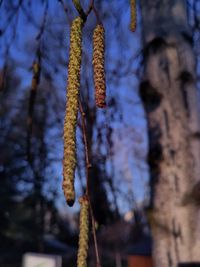Issued on April 3, 2025
Pollen forecast for Carinthia for the period from April 3 to 10, 2025
The pollen release of gray alder, black alder and hazel has ended for the vegetation year 2025. Only a few pollen grains from climatically disadvantaged locations will be able to enter the airspace.
The birch pollen count will become increasingly important in the forecast period. This year, in contrast to last year, birch pollen release is expected to be moderate to average. Nevertheless, the allergic irritation threshold can be significantly exceeded again and again and this can result in a high health risk for people who react to birch pollen with allergic symptoms. At present, the birch pollen flight is still concentrated in the hours from late morning until early evening. However, it must be expected that with the continuing release of pollen, the allergic irritation threshold can be reached more and more frequently at other times of the day.
In addition to the start of birch flowering, ash and hornbeam dusting will also begin during the forecast period. The hornbeam, which is widespread in central and eastern Carinthia, has an above-average number of male flower catkins this year. It is therefore to be expected that hornbeam pollen release will also be above average. For people who are sensitive to birch pollen, hornbeam pollen can also trigger symptoms.
In any case, the time of day with the lowest pollen load remains the early morning. For this reason, it is advisable for people who react to birch and ash pollen with allergic symptoms to ventilate living spaces only in the early morning hours.
The best way to avoid exposure to birch pollen is within dense forests of spruce and other conifers and in the higher mountain regions above an altitude of approx. 1500 meters.
Wind currents from the south can transport hop hornbeam and hornbeam pollen to Carinthia. Hop hornbeam pollen in particular can cause symptoms in people who are allergic to birch pollen. If you are staying in areas south of the Alps (Slovenia, Friuli and Istria), you should therefore expect a high allergic reaction to hop hornbeam pollen.
Other types of pollen in the airspace of Carinthia come from poplar, elm, yew and various willow species. However, the pollen from these plant species rarely leads to allergic reactions.
Dr. Susanne Aigner
Responsible for the content
Amt der Kärntner Landesregierung
Abteilung 5 (Kompetenzzentrum Gesundheit)
UA Sanitätswesen
Pollenwarndienst Kärnten
Dr. Helmut Zwander, Dr. Susanne Aigner und Mag. Herta Koll.
Mittelfristige Prognose basierend auf Modelldaten und Pollenzählungen.
Auszugweiser oder vollständiger Nachdruck und Veröffentlichung nur unter Angabe der Quelle gestattet.
Wetterdaten und Prognosen basierend auf synoptischen Daten:
GeoSphere Austria, Bundesanstalt für Geologie, Geophysik, Klimatologie und Meteorologie (ehemals ZAMG).
zum Team


